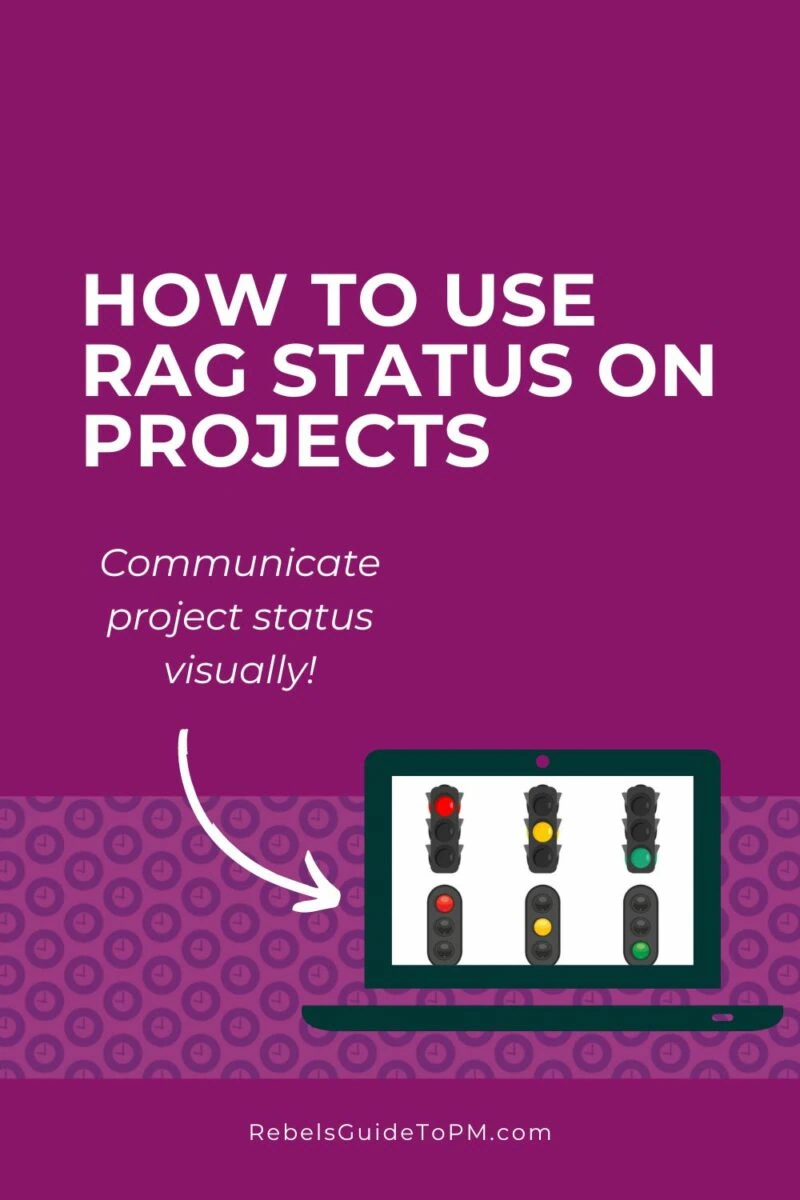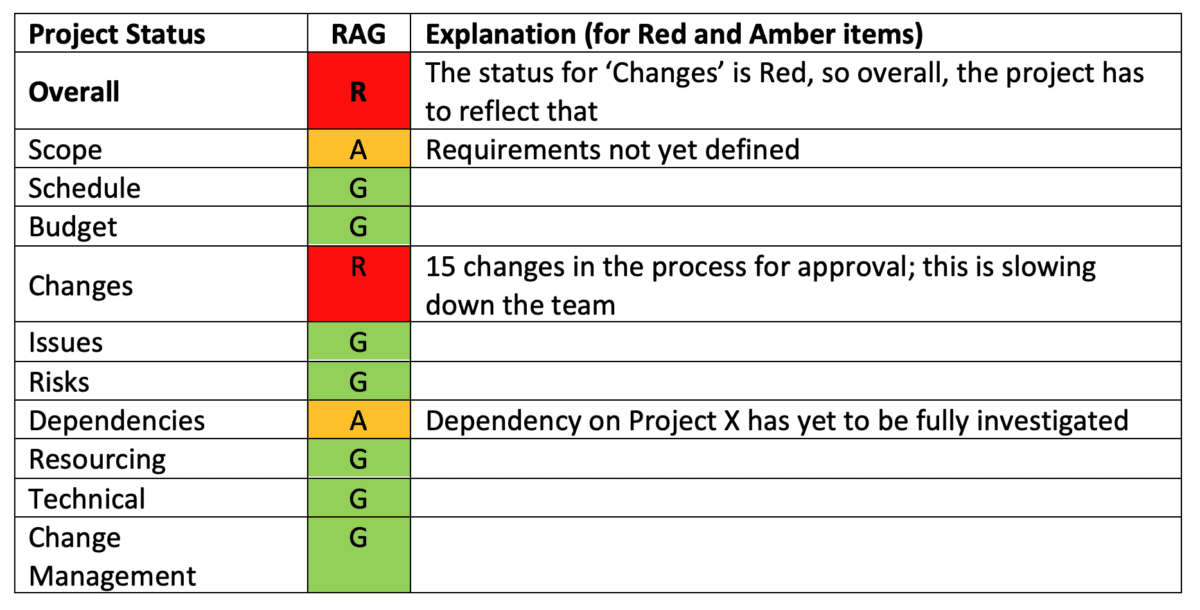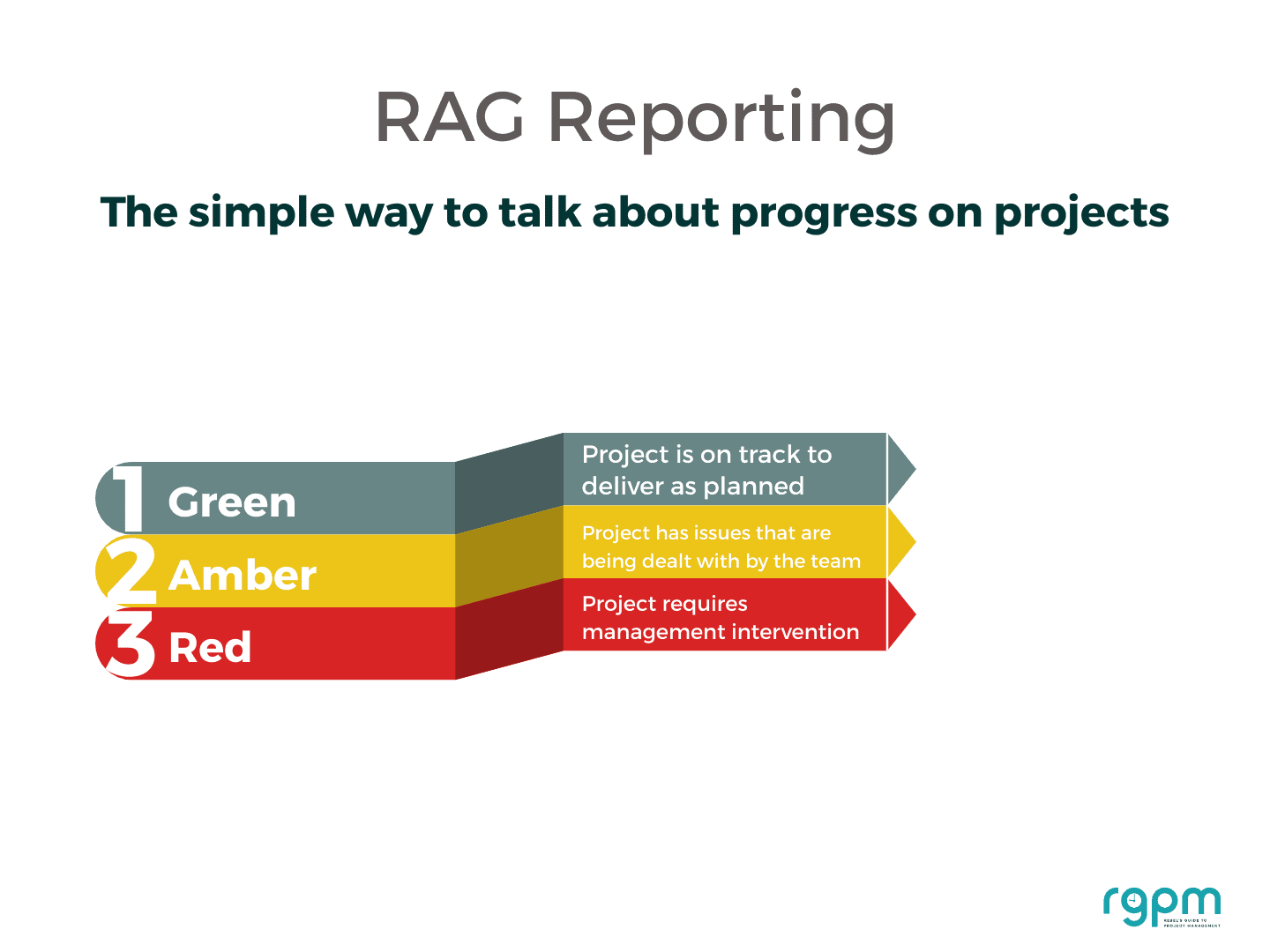RAG (and BRAG) status and how to use them on projects
Have you seen project status reports with colored boxes in different shades of green, amber, and red? Or project names written in those colors where the rest of the text is black? That’s the RAG status of the project.
According to PMI, 11.4% of investment is wasted due to poor project performance. RAG reporting is a good way to draw management’s attention to projects that need support. When this support is provided and the project is brought back under control, less of your investment will be wasted.
Let’s learn more about RAG in project management because it’s a really useful, visual way of communicating project status.
What is RAG is project management?
The RAG acronym stands for Red, Amber, Green. These colors make up the traffic light colors coding scheme for categorizing project status.
The project RAG status will either be Red, Amber or Green. These colors represent different types of management action required and are a shorthand for talking about projects going well or those in trouble.
The table below shows what the colors mean.
| B | Blue | Project closed |
| R | Red | Project is likely to deliver late/over budget |
| A | Amber | Project has missed some targets but overall end date/budget is not at risk |
| G | Green | Project on track |
As you can see, this equates to the acronym BRAG. Some companies only use RAG, and drop the Blue. Some use RYG (Red, Yellow, Green), although that is harder to pronounce!
And some companies don’t use colors at all, instead favoring smiley faces, weather symbols or some other graphical indicator that shows if a project is progressing to plan, struggling a bit or in trouble.
Different companies use different RAG status definitions behind the colors, so the exact interpretation for your company might be slightly different. Check with your PMO.

What is a ‘Red’ project?
A ‘Red’ project is one that is challenged for some reason. It could be over budget, running behind schedule or have uncontrolled scope changes (or all three). There are underlying problems, even if on the surface work is happening and the team is busy. Or there might be in-your-face problems.
Either way, ‘Red’ projects need management attention, beyond what you can give them as a project manager.
The Red status is shorthand for saying that the project is in trouble. For example:
- There are issues that need escalating. The project manager is unable to deal with the issues herself and/or doesn’t have a plan to be able to do that. Senior management support is needed.
- There are issues with requirements or project scope that will result in significant extra work or cost that need to be approved.
- There’s a significant level of project risk with no plans to address that risk.
- A lack of resources is impacting the team’s ability to get the work done and the project manager cannot resolve this herself.
- The completion date has slipped by more than 4 weeks/outside tolerance.
- The budget is overspent by more than 10%/outside tolerance.
Your PMO should define exactly what ‘Red’ means and then you can check your project performance against those measures. If you are not able to justify why you are at Amber status, then report your project as Red.
In my experience, most Red issues relate to the project schedule (the work is running behind) or budget (the work is costing more than we thought).
Read next: How to create a project budget
What should you do if your project is Red?
There’s no shame in reporting a project as Red. It simply means that management attention is required and is a good way to get stakeholders to focus on what they need to do to ensure the project delivers a successful result.
The action to take is first to be honest with the situation and ‘peel back the curtain’ to show exactly what is going wrong and why.
Then work with senior management to review the status of the project. Look for what can be fixed and salvaged. Dig into the root causes of issues. Close what you can, picking off priority problems first.
Be honest with clients: if you are in an agency setting or delivering work for external customers, there comes a time when you have to be upfront about the state of the work.
You’ll need their support to create a recovery plan, as in my experience, recovering a project means you can finish the work but it will cost more and be late.
If, after you have thoroughly picked apart the problems, the sponsor and team feel that there is nothing worth saving in this project, it’s time to close it down. It’s better to close down a project than throw money at something that is not delivering and has no capacity to be able to deliver the business benefits that were promised or meet the intended business objectives.
What is an ‘Amber’ project?
An ‘Amber’ project is one that may need management attention by the project team are managing within their existing powers and authority levels at the moment. This status means the project has missed some targets – perhaps it is running late on certain tasks or is overspent on particular work packages – but overall the team can still bring the project to completion within the currently approved tolerances.
Here are some examples of what might define a project as being Amber. Your own PMO may set slightly different parameters:
- The budget is overspent in certain areas but this is not going to affect the overall project budget or push the spend outside of approved tolerances.
- Certain tasks or milestones are delayed but the overall delay is within tolerance OR the delay is not going to affect the project completion date.
- There are issues with project requirements or scope but they are being managed by the team.
- There is a lack of resources to deliver the work but it is being managed by the team and doesn’t (yet) need intervention from the project sponsor or steering group.
- There is resistance from stakeholders regarding the required organizational change but the team has a plan to address this.
- There are more than 5 open issues with a status of ‘high’ but the team is managing these at the moment.
What should you do if your project is Amber?
The action for an Amber project is a watching brief. That means you keep an eye on it. If you are the project sponsor, make sure you check in regularly with the project team. Be prepared to offer help if asked.
If you are the project manager, keep a close eye on the project status and check in with the team regularly – perhaps more often than usual so you spot any new issues earlier. Work on the open issues and try to get the project back on track.
What is a ‘Green’ project?
A project with the status of ‘Green’ is one that is progressing to plan. Green means there are no concerns for senior leadership to worry about and no management intervention is required. The project manager and team have everything under control.
Your project will be at Green status if:
- The budget forecast at completion is the same as what you had planned.
- You are on track to hit all delivery dates – if individual tasks are delayed by a day or two, this is not affecting milestones.
- There are no issues that the project manager or team needs help resolving.
If you report your project as Green, be prepared to justify it. Sponsors like to have evidence that their initiatives really are going as well as you say they are!
Never report a project as Green when you know there are problems but just don’t want to say. It’s very unlikely you will be able to resolve them satisfactorily by yourself, without the sponsor finding out, and then all you are doing is delaying telling them the bad news until later… potentially so late that they can’t help you put it right.

How to use RAG statuses in project reporting
The RAG rating for your project (so, the color that most closely represents your assessment of how the project is doing) is mainly used in reporting.
On a project status report, the appropriate color can be shown as an indicator at the top of the page, giving the reader a fast visual sign that summarizes project status. RAG can be used for the following reports:
- Weekly status report
- Monthly status report
- Risk report (add a RAG status to each project risk to show the level of risk)
- Project board report
- Portfolio or program reporting.
Basically, anywhere you need to tell people about status, you can use RAG.
You could also break down the BRAG color scheme for each area of the project such as scope, quality, budget, risks and so on. This would require you to flag each individual area with a color (RAG indicators), like in the table below. Choose the cell and change the background to the appropriate shade.

This way of color-coding project status by section of the project works best for large, complex projects, especially where there are multiple workstreams or different team leaders responsible for different sections of the work.
Where an element is reported as being Amber or Red, there is extra text added to show what has caused that and what corrective action is being taken to return the project to the status of green. On one project, we had to report the date by which we thought the project was going to be green again – that was tricky to forecast, to be honest.
In my experience, on small and medium-sized projects it is easier to stick with one color indicator that represents the project manager’s opinion of overall project status.
Just ‘RAG it’!
I hear this from portfolio managers, program managers, and senior leaders who want a high-level overview of all the projects within a department or division. They are not interested particularly in the detail of each project but they want to see all the open projects with a RAG rating.
In those situations, I would create a RAG report that shows my project names (or those within the portfolio on which I’m reporting) and the RAG analysis via color coding and also writing the name of the color in case they print the report in black and white or look at it on an ancient device.
I would also add a recovery plan. Much like the table above, this is just a line or two that describes why a project is reported as being Red or Amber and what the team is doing to put it right.
Is RAG reporting reliable?
RAG reporting is only as good as the project manager’s assessment. If the project is reported as Green but actually it’s really struggling, then that doesn’t serve anyone. Project teams need to be free from a blame culture to be able to report accurately, regardless of the RAG ‘score’ of their project. It’s not a competition to be the most green…
…and some project managers seem to have a natural tendency to report everything as green, even if it’s obvious something is wrong! There needs to be a level of respectful challenge. Be a critical friend to the project managers in your department if you see that optimism bias happening.
That’s why it is important for the PMO to set up RAG status definitions. When you have parameters like ‘the budget is forecasted to be more than 15% overspent’ or ‘more than 3 milestones are forecasted to be 2 weeks late or more’ then project managers have adequate guidance on what the status means and how they will be interpreted.
If your PMO does not have a set of defined meanings for what the different colors represent, then I would recommend including the ones you have used as a footnote on your report. Simply add a couple of sentences about the RAG meaning that say something like:
- Green: Project is on track to deliver as planned
- Amber: Project has issues that are being dealt with by the team
- Red: Project requires management intervention
This avoids there being a different interpretation of what the colors mean. For example, some managers I have worked with have assumed that Red means the project team is struggling but “it’s all under control”. That’s not the case at all!

Managing senior stakeholders’ responses
Let’s be honest: no one wants to see a project they sponsor flagged as Red on some report.
Executives like to think they have a handle on what is going on and how the work is being managed. They don’t want to be linked to something that is failing. So the reaction of senior managers to RAG statuses is definitely something to bear in mind.
Do this: Warn them that the report is going to show that the project is in need of management attention and will be reported as Red. When I did this, my sponsor quickly sprung into action, resolved a few things and we got back to Amber in a couple of hours.
Not all sponsors (or issues) will respond like this, but give them a chance to get used to the idea that their project is going to come under scrutiny before you send the report to everyone.
Don’t do this: Spring it on them, while copying the report into loads of other stakeholders. No one likes surprise bad news.
Using project management tools
Many teams use project collaboration tools to prepare reports and the good news is that this way of reporting status is often built into the software you use. If it isn’t, you’ve often got the option to set bespoke colors so you can change task highlights or risks to show in the colors of your choice.
Project dashboards also have project status indicators built in to let you filter on projects in trouble and so on. If you don’t have the option in your tool, create a custom field so project managers can enter the information manually.
If you are going ‘old school’ with spreadsheet-based portfolio management, then simply change the cell color to whatever you want it to be.
FAQ
Should you share RAG status with external stakeholders?
That depends! Transparency and ethical behavior in project management are important. If the client needs to know, or they can help with the corrective action, it is best to tell them.
Your next steps
Here’s what to do next:
- Make sure you know what the RAG status definition is for the color you are using. Create a definition if you don’t have one, so it’s not a subjective assessment of project status based on the project manager’s best guess.
- Make sure RAG is reported regularly, if it isn’t at the moment.
- Talk to your sponsor and leadership team about RAG as a concept of project status reporting if they are not familiar with it, and let them know what is expected of them for a Red project.
- Read on for Real life tips for managing Red projects and getting back to Green.
